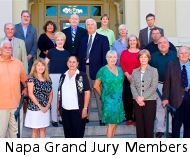3/28/2011
California: Grand Jury Slams Right Turn TicketsNapa, California grand jury questions red light camera program dependent on right turn tickets and short yellows for revenue.

The Grand Jury in Napa, California last month issued a report calling for reform and refunds in the city's red light camera program. The jurors uncovered yellow light timing discrepancies and an unusual dependence upon right-turn tickets to generate revenue at the most productive intersection. The Australian vendor Redflex Traffic Systems began issuing tickets in May 2009, and citations at four intersections now cost $475 each. So far, 9278 tickets worth $4 million have been mailed -- 3789 of which were sent to vehicle owners that turned right on red.
The program's top intersection, Highway 29 and Highway 121, gives out 78 percent of its tickets for turning right on red. The location has never had an right-turn accident problem. From 2004 to 2008, the intersection experienced 77 accidents, only one of which was related to a right turn -- a non-injury collision where a speeding car hit a fixed object, not another vehicle or pedestrian. The jurors questioned the emphasis on right-turn ticketing, which Redflex requires in its contract.
"Based on this accident history, the automated red light enforcement of right turn stops has limited direct benefit of reducing accidents," the report stated.
Jurors also noted that Caltrans ignored its own stated policies by allowing red light camera enforcement at the intersection without first performing a study to examine engineering alternatives. The jurors found this resulted in drivers being shortchanged by the signal timing at this 60 MPH approach. When the camera was first installed, drivers had a 5.4 second yellow after a circular green signal, but after a protected green arrow the yellow dropped to just 3.2 seconds. On May 13, 2010 Caltrans engineers increased the 3.2 second yellow to 3.8 seconds. This had a big impact.
"Following the change in yellow interval time and enforcement procedures, the average number of right turn citations dropped significantly," the report noted. "To verify that the change in citations was not a result of effectiveness of the automated red light enforcement system's ability to modify driver behavior, the grand jury also evaluated the right turn citations at the First/Jefferson intersection. The grand jury found that the number of right turn citations remained relatively steady over the first eight months of operation at this intersection."
New state regulations are expected to prohibit having two different yellow times on the same signal, so Napa at some point quietly implemented an informal procedure giving a 1.6 second "grace period" to the shorter yellow phase where tickets would not be issued. The grand jury criticized the interpretation of the law that Caltrans used to justify the shorter yellow.
"Had Caltrans applied the approach speed as the criteria for setting the SH 29/12/121 signal, the southbound right turn yellow change interval would have been set at 5.4 seconds for all signal phases," the report stated.
The jurors asked the county to seek clarification from the attorney general about the proper interpretation of the statute. Jurors noted that accidents have decreased since cameras were installed, but that may not be as a result of the photo enforcement program.
"The data more clearly shows that the incidents of injury accidents have been on a steady decline since 2007 with the highest level of decline occurring between 2007 and 2008 prior to the installation of the automated red light enforcement system," the report stated.
The report recommended refunds to the estimated 1000 vehicle owners ticketed under the old signal timing practice. A copy of the report is available in a 1.7mb PDF file at the source link below.


